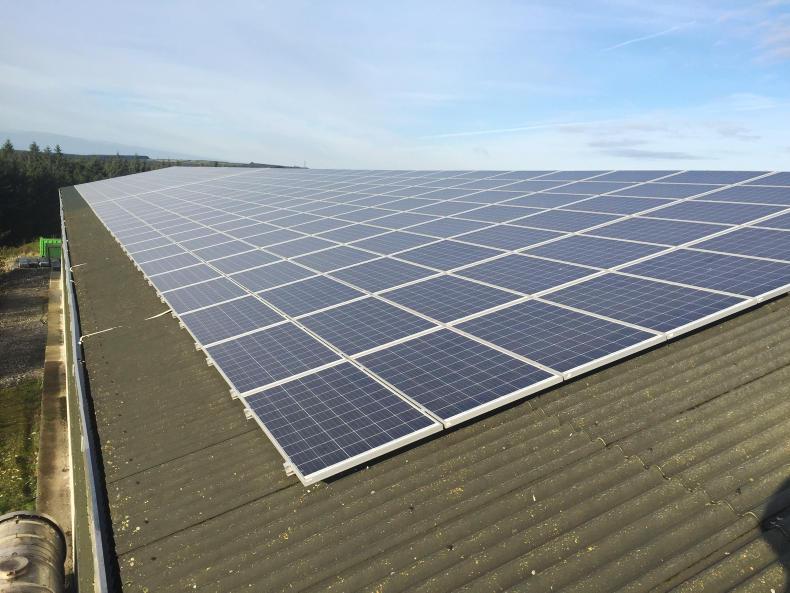Drystock farmers are dependent on a tariff to sell small amounts of electricity into the national grid if they are to take part in renewable energy generation, Alan Jackson of the Tipperary Energy Agency told a recent ICSA meeting in Castletown Geoghegan, Co Westmeath.
A part-time organic beef farmer himself, Jackson said prices had fallen by €1/kg in recent years and many were looking for this opportunity to generate an additional income.
However, unlike dairy, pig or poultry farmers, they don't consume much power on their own farm.
"Drystock farmers like myself don't really have an electric load, so you want to be able to sell it," Jackson said.
A new EU directive will force Ireland to introduce payments for such overspill electricity by 2021.
In the meantime, Jackson said a current Sinn Féin bill on microgeneration may speed up the process.
Uncertainty
A farmer in the audience highlighted the uncertainty and delays.
"How can you plan for it when you don't know what you're going to get out of it? It's like beef cattle," he said.
"Everybody should be able to put solar panels on their shed and sell the excess electricity to the grid," said ICSA Offaly chair William Reid.
He encouraged farmers to raise this issue with candidates in the upcoming European election.
At least 120 cows for an AD
Another avenue to generate renewable fuel is anaerobic digestion (AD).
Tom Larkin of TGL Agri-Environmental said he had developed a plant processing municipal waste in Loughmore, Co Tipperary.
In his experience, "AD is for farmers with a constant supply of feedstock" such as slurry and grass, crops or waste.
The minimum size of a herd to supply an AD is around 120 cows, but smaller farmers could make it work as a community project through a co-op, Larkin said.
I'd strongly recommend you do a carbon footprint assessment of your farm
"If you're considering building an AD, the goal is to reduce carbon emissions from your farm.
"I'd strongly recommend you do a carbon footprint assessment of your farm first," he added.
Larkin spreads the digestate leftover from gas production in his AD on neighbouring farms, after having a nutrient management plan approved by Irish Water.
"We found that farmers have significantly reduced the amount of nitrogen they apply to land since using digestate," he said.
Read more
Focus on farm security and safety at Ballymahon Mart event
EU approves renewable heat scheme
New TAMS grants for solar panels
Drystock farmers are dependent on a tariff to sell small amounts of electricity into the national grid if they are to take part in renewable energy generation, Alan Jackson of the Tipperary Energy Agency told a recent ICSA meeting in Castletown Geoghegan, Co Westmeath.
A part-time organic beef farmer himself, Jackson said prices had fallen by €1/kg in recent years and many were looking for this opportunity to generate an additional income.
However, unlike dairy, pig or poultry farmers, they don't consume much power on their own farm.
"Drystock farmers like myself don't really have an electric load, so you want to be able to sell it," Jackson said.
A new EU directive will force Ireland to introduce payments for such overspill electricity by 2021.
In the meantime, Jackson said a current Sinn Féin bill on microgeneration may speed up the process.
Uncertainty
A farmer in the audience highlighted the uncertainty and delays.
"How can you plan for it when you don't know what you're going to get out of it? It's like beef cattle," he said.
"Everybody should be able to put solar panels on their shed and sell the excess electricity to the grid," said ICSA Offaly chair William Reid.
He encouraged farmers to raise this issue with candidates in the upcoming European election.
At least 120 cows for an AD
Another avenue to generate renewable fuel is anaerobic digestion (AD).
Tom Larkin of TGL Agri-Environmental said he had developed a plant processing municipal waste in Loughmore, Co Tipperary.
In his experience, "AD is for farmers with a constant supply of feedstock" such as slurry and grass, crops or waste.
The minimum size of a herd to supply an AD is around 120 cows, but smaller farmers could make it work as a community project through a co-op, Larkin said.
I'd strongly recommend you do a carbon footprint assessment of your farm
"If you're considering building an AD, the goal is to reduce carbon emissions from your farm.
"I'd strongly recommend you do a carbon footprint assessment of your farm first," he added.
Larkin spreads the digestate leftover from gas production in his AD on neighbouring farms, after having a nutrient management plan approved by Irish Water.
"We found that farmers have significantly reduced the amount of nitrogen they apply to land since using digestate," he said.
Read more
Focus on farm security and safety at Ballymahon Mart event
EU approves renewable heat scheme
New TAMS grants for solar panels






 This is a subscriber-only article
This is a subscriber-only article










SHARING OPTIONS: